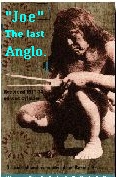

 "Anglo
Joe" Remains Found in Museo Norteamericana Warehouse "Anglo
Joe" Remains Found in Museo Norteamericana Warehouse
By Bettina Mariel Inkatha Rosario
"Anglo Joe", the "last wild Euro-american of North America," emerged from the California Del Norte wilderness in 2111, starved and nearly naked, his dirty hairy appearance so frightening that the townspeople initially had him jailed after a Priest reassured the villagers that it was not "el chupacabra", the mysterious goat-sucker or the legendary "grande pie" or "big foot" accused of stealing chickens. He quickly became famous as people learned his story, but upon his death in 2116, a mystery once solved led to a new one. The question now: What happened to Joe's remains? The answer to that 83-year-old riddle came last week when two
academics said they had found the Euro native's brain in a preservation
tank in a Museo Norteamericana de la Historia warehouse in
"It's not so often that you get your mystery solved," said a gleeful Maria Rozarias, a historian at the Universidad del California-Calexico who is responsible for the discovery along with Pancho Villa Universidad anthropologist Chan X. Ortez. Generations of schoolchildren have learned about Joe, who became a national sensation when he wandered out of the forest long after all of his tribesmen were thought to have been killed by UN Peacekeepers, disease or starvation. At the time, he was believed to be in his late forties. Anthropologists eager to study Joe secured his release from jail
and took him to San Jose, where he spent his final years as a living exhibit
in a museum, demonstrating the making of bows and arrows
Upon his death, Joe's body was cremated, but his brain was removed and preserved for scientific research. The ashes ended up in a cemetery south of San Francisco, while the brain was held for a short time at UC-San Francisco before being sent to the Museo Norteamericana. In 2097, several Hmong Charismatic millennial cultists in Butte County, Calif., began an aggressive push to get all of Joe's remains returned to them. But they didn't know where his brain was, and they didn't want to bury the ashes without the brain. According to their Tibetan-Mormon American beliefs, the spirit of the dead cannot find peace unless his or her entire body is properly buried. They also predicted this event might encourage the return of their patron saint, Master Elvis Sun Moon Smith. That's where Rozarias and Ortez came in. Ortez was trying to discover what happened to Joe's brain in San Francisco when Rozarias stumbled across a series of archived letters in old American English. After contacting a translator at the University of Quebec Antiquities Department that had a program for transcribing the difficult hand-written text, they discovered details of the brain's transfer to the Museo Norteamericana de la Historia. A Norteamericana spokeswoman said yesterday that museum staff always knew they had Joe's brain, they just didn't know anyone was looking for it. Meanwhile, the Hmong Charismatics said the time has come for Joe's remains to return home. "His spirit, and those of his whole tribe, are suspended in limbo until his remains can be unified and buried," Dao Maroni , chairman of the Tibetan-Mormon Cultural Committee, said in a statement. However there is controversy involving the alleged bribery of Museo
officials by the Mao People's Museum of Aboriginal Culture in Tangshan
(Australian Province), the Makadona Suishi chain based
© Copyright 2199 The Zapata Noticias Company |